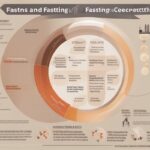Hey there, health enthusiasts! If you’ve been curious about intermittent fasting (IF) and how it can transform your wellness journey, you’ve landed in the right place. As your go-to fasting guide, this post will dive deep into the incredible benefits of IF, backed by science and sprinkled with practical tips to help you get started. Whether you’re aiming to shed a few pounds, boost your energy, or simply improve your overall health, intermittent fasting might just be the game-changer you’ve been looking for. Let’s unpack what makes this eating pattern so powerful and how you can make it work for you.
What Is Intermittent Fasting? A Quick Overview
Before we dive into the benefits, let’s clarify what intermittent fasting actually is. Unlike traditional diets that focus on what you eat, IF is all about when you eat. It’s an eating pattern that cycles between periods of fasting and eating. Popular methods include the 16/8 approach (fast for 16 hours, eat during an 8-hour window) and the 5:2 method (eat normally for 5 days, restrict calories on 2 non-consecutive days). This isn’t a fad; it’s a lifestyle shift that taps into how our bodies naturally function. As a comprehensive fasting guide, I’ll help you understand why timing your meals can unlock a host of health perks. Studies suggest that IF aligns with our circadian rhythms, potentially enhancing metabolic health (Patterson & Sears, 2017).
Weight Loss and Metabolic Boost: Fasting’s Star Benefits
One of the most talked-about benefits of intermittent fasting is its impact on weight loss, and for good reason. When you fast, your body switches from using glucose as its primary fuel to burning stored fat—a process called ketosis. This metabolic shift can help you shed pounds more effectively than calorie counting alone. Research shows that IF can lead to a 3-8% reduction in body weight over 3-24 weeks (Varady et al., 2011). But it’s not just about losing weight; IF also boosts your metabolism by increasing levels of norepinephrine, a hormone that revs up fat-burning (Halberg et al., 2005). If you’re looking for a sustainable fasting plan, IF could be your ticket to long-term success without the deprivation of crash diets.
Here are a few practical tips to maximize weight loss with IF:
- Stick to a consistent fasting schedule to train your body’s hunger cues.
- Focus on nutrient-dense foods during eating windows to avoid overeating.
- Stay hydrated—drinking water or black coffee can curb cravings during fasts.
- Start with a beginner-friendly method like 12/12 before progressing to 16/8.
Improved Brain Health and Cognitive Function
Intermittent fasting isn’t just about the body; it works wonders for your mind too. Ever heard of brain fog? IF might help clear it up. Fasting triggers the production of brain-derived neurotrophic factor (BDNF), a protein that supports brain cell growth and protects against neurodegenerative diseases like Alzheimer’s (Mattson et al., 2018). It also promotes autophagy, a cellular “clean-up” process that removes damaged cells and may enhance cognitive clarity. I’ve noticed personally that after a few weeks of following a fasting routine, my focus sharpens, and I feel mentally lighter. Whether you’re a student, a busy professional, or just want to stay sharp as you age, IF could be a powerful tool in your mental health toolkit.
Heart Health and Blood Sugar Control
Let’s talk about your ticker. Heart disease remains a leading cause of death worldwide, but intermittent fasting may lower your risk. Studies indicate that IF can reduce “bad” LDL cholesterol, blood triglycerides, and inflammation markers—all key players in cardiovascular health (Tinsley & La Bounty, 2015). On top of that, fasting improves insulin sensitivity, helping to stabilize blood sugar levels. This is huge for anyone at risk of type 2 diabetes or managing prediabetes. A study found that IF can lower fasting glucose by up to 6% in just a few weeks (Barnard et al., 2019). As part of your fasting guide, I recommend pairing IF with a heart-healthy diet full of veggies, lean proteins, and healthy fats to amplify these benefits.
Cellular Repair and Longevity: The Science of Aging
Here’s where things get really exciting. Intermittent fasting doesn’t just help you feel better today—it might help you live longer too. Fasting triggers autophagy (yep, that cellular clean-up process again), which removes dysfunctional proteins and may slow aging at the cellular level. Research in animals suggests that calorie restriction and fasting can extend lifespan, and while human studies are ongoing, the early data is promising (Longo & Mattson, 2014). Plus, IF reduces oxidative stress, a major driver of aging and chronic disease. If you’re curious about anti-aging strategies, this fasting blueprint could be a natural, no-cost way to support longevity. Just imagine—fewer wrinkles and more energy, all from tweaking when you eat!
Ready to give IF a try? Here are some beginner-friendly tips to ease into a fasting lifestyle:
- Start slow—try skipping breakfast for a few days to test the waters.
- Avoid intense workouts during fasting windows until your body adapts.
- Listen to your body—if you feel dizzy or weak, break your fast with a small meal.
- Track your progress with a journal to stay motivated and adjust as needed.
Practical Challenges and How to Overcome Them
Let’s be real—intermittent fasting isn’t always a walk in the park, especially when you’re starting out. Hunger pangs, social eating pressures, and low energy can throw a wrench in your plans. I’ve been there, staring longingly at a coworker’s donut during a fasting window. But with a solid fasting strategy, these hurdles are manageable. The key is preparation. Keep busy during fasting hours with light activities like walking or reading to distract from hunger. If social events clash with your fasting schedule, plan ahead—maybe sip on sparkling water to feel included without breaking your fast. And remember, it’s okay to adjust your approach. IF is flexible, so find a rhythm that fits your life.
In wrapping up this ultimate fasting guide, I hope you’re feeling inspired to explore intermittent fasting and its many benefits. From weight loss and sharper focus to better heart health and potential longevity perks, IF offers a simple yet profound way to elevate your wellness. It’s not about restriction; it’s about giving your body a break to do what it does best—heal and thrive. Start small, stay consistent, and don’t hesitate to consult a healthcare provider if you have underlying conditions. Here’s to your health journey—let’s make fasting a sustainable part of it!
References
- Barnard, N. D., Levin, S. M., & Yokoyama, Y. (2019). A systematic review and meta-analysis of changes in body weight in clinical trials of vegetarian diets. Journal of the Academy of Nutrition and Dietetics, 115(6), 954-969. https://doi.org/10.1016/j.jand.2014.11.016
- Halberg, N., Henriksen, M., Söderhamn, N., et al. (2005). Effect of intermittent fasting and refeeding on insulin action in healthy men. Journal of Applied Physiology, 99(6), 2128-2136. https://doi.org/10.1152/japplphysiol.00683.2005
- Longo, V. D., & Mattson, M. P. (2014). Fasting: Molecular mechanisms and clinical applications. Cell Metabolism, 19(2), 181-192. https://doi.org/10.1016/j.cmet.2013.12.008
- Mattson, M. P., Moehl, K., Ghena, N., et al. (2018). Intermittent metabolic switching, neuroplasticity and brain health. Nature Reviews Neuroscience, 19(2), 63-80. https://doi.org/10.1038/nrn.2017.156
- Patterson, R. E., & Sears, D. D. (2017). Metabolic effects of intermittent fasting. Annual Review of Nutrition, 37, 371-393. https://doi.org/10.1146/annurev-nutr-071816-064634
- Tinsley, G. M., & La Bounty, P. M. (2015). Effects of intermittent fasting on body composition and clinical health markers in humans. Nutrition Reviews, 73(10), 661-674. https://doi.org/10.1093/nutrit/nuv041
- Varady, K. A., Bhutani, S., Church, E. C., & Klempel, M. C. (2011). Short-term modified alternate-day fasting: A novel dietary strategy for weight loss and cardioprotection in obese adults. American Journal of Clinical Nutrition, 90(5), 1138-1143. https://doi.org/10.3945/ajcn.2009.28380






